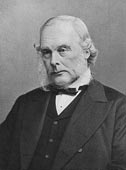The Lister Lecture: Regenerating the Lung
 Joseph Lister
|
Surgeon scientist Joseph
Lister discovered the effectiveness
of antisepsis in the
19th century. He based his
work on the use of carbolic
acid, a derivative of
creosote, which was used
to prevent the wood in railway
ties from rotting. He
used carbolic acid (phenol)
to prevent infection in compound fractures and in
abscesses. After confirming Semmelweis’s neglected
discovery that surgeons can transmit infections
from septic patients, Lister introduced the revolutionary
concept of asepsis to the practice of surgery.
|
Tom Waddell began his Lister Prize lecture at Surgical
Grand Rounds by showing us a lung transplant patient
who was totally transformed from near lifelessness to
athletic vigor by her treatment. The effectiveness was
breathtaking. “The limit to this therapy is the severe
shortage of donor organs and the fact that the treatment
involves allogeneic tissues. Mechanical support using
ECMO (extracorporeal membrane oxygenation) as an
alternative has all of the limits that go with pumps.” Tom
described the wide breadth of regenerative medicine
approaches explored as alternative solutions in his lab.
Cell therapy can improve injured organs and enhances
endogenous repair, but cannot replace function. Cell
replacement with precursors requires removing endogenous
stem cells and then putting in gene- corrected
progenitors. That is regularly done for bone-marrow
transplantation, as all the cells can be wiped out and the
marrow repopulated. It is much more difficult in the
lung. “Amy Wong in our lab discovered a unique population
of bone marrow cells with a special propensity to
populate the lung in mice. Sarah Gilpin studied sternal
marrow in lung transplant recipients and found the
same type of cells in humans. Administration of Clara
Cell Secretory Protein (CCSP) positive stem cells via the
airway
|
causes proliferation of the recipient’s cells, restoring
the respiratory epithelium, and this may be useful in
a variety of lung conditions. Using the combination of
ablation of airway epithelium followed by transtracheal
delivery of bone marrow cells, Pascal Duchesneau has
achieved remarkable success in cystic fibrosis mice.”
An alternative approach to the shortage of donor
organs is to grow them in the laboratory. For example,
ongoing work in Tom’s lab is evaluating the role of
decellularization and recellularization in the creation of
new airways and lungs themselves. Tracheal replacement
using decellularized tracheal allografts is a promising
approach. “The decellularization techniques in current
use tend to make the trachea floppy but Siba Haykal is
evaluating various approaches to combat this challenge.
The cells used to repopulate must be arrayed in order
to move foreign material from the airway via the mucociliary
carpet. John Soleas is using sophisticated bioengineering
approaches such as nanotopography of the
underlying substrate which may allow creation of this
orderly orientation. Geff Frost has developed a device
for decellularizing the entire lung by rotating it during
perfusion to thoroughly distribute the decellularizing
solution. The next step will be to recellularize the entire
lung which will require massive numbers of epithelial
and endothelial cells.
One such approach is to use partial reprogramming
of lung cells towards induced Pluripotent Stem (iPS)
cells. Stem cells retain their epigenetic memory of their
tissue of origin. Lily Guo is working to determine if
partial re-programming, for a short period of time will
allow expansion of lung epithelial cells, which could
then revert to lung epithelium upon withdrawal of the
reprogramming stimuli.”
Tom concluded his lecture by acknowledging the
incredible hard work of the many members of his
lab, past and present. He also expressed his thanks to
the other members of the Thoracic Division and the
Department of Surgery for the support of this work.
M.M.
|